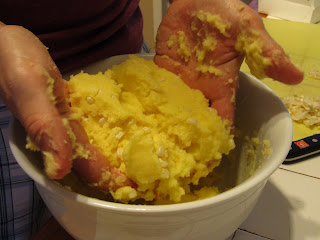One note about my recipe is that I use foil instead of corn husk for the wrapping. This was a trick I learned from a friend at Cristo Rey, a church I attended in Chicago for a couple of years. I know how to do this with corn husk, but it's really time consuming and doesn't add anything to the dish as far as I can tell.
Ingredients:
For the Masa (Dough):
4 c. Very Warm Water
1 T. Salt
1 T. Corn or Canola Oil
3/4 c. or one ear of Corn
 |
| Because I just can't do things the easy way! |
2 c. Precooked Corn Flour
*Don't use a course corn meal, or it won't absorb the water. A brown corn flour works, but the best kind I have found are two Venezuelan brands. There is a way to make it from corn and from corn meal, but it's another thing that's rather complex. Perhaps another day.
 |
| Most common/popular brand - white corn |
 |
| My favorite brand - yellow corn |
2 T. Corn or Canola Oil
1/2 med. Yellow Onion - Chopped
2 sm. Chile Peppers - minced
1 c. Vegetables of your choice - Chopped
3/4 c. or one ear of Corn
1 c. Beans - any kind - boiled and drained
2 cloves of Garlic - Minced
1 T. Chile Powder
1 t. Cumin
Salt - to taste (if desired)
Directions:
1. To make the filler, heat 2 T. of Oil in a large skillet over medium heat. Sauté the Onion, adding the Garlic, Chile Powder, Cumin and Salt. When the Onions begin to soften, add the Chiles. Then add the Vegetables and 3/4 c. Corn. Sauté over med-low heat until they soften, stirring occasionally.
2. While the vegetables are sautéing, put 4 c. of Hot/Warm Water in a medium to large mixing bowl. Add 1 T. of Oil and 1 T. Salt. Then, add the 3/4 c. or Corn. Next, stir the water with your hand, and slowly mix in the Corn Flour, stirring, then kneading it until it gets to be a sticky, doughy
consistency.
 |
| Mixing flour into water/corn mixture |
 |
| Kneading the masa |
 |
| What it should look like |
3. Add the beans to the sautéing filler. Stir the filler well, and let it cook for apx. 1 minute. Then, remove from heat.
4. Put a large pot on the stove on high, about 2/3 full of water. Heat it to boiling
5. While the water is boiling, cut about a 12" long sheet of aluminum foil. Press apx. 1/2 c. of masa onto the foil to where it's about a 1/4" thick.
6. Put 1/3 c. of filling onto the masa. Then cover filling with another layer of masa, trying to seal the filling completely inside of the masa.
 |
| It doesn't have to be pretty at this point. |
7. Fold the aluminum foil up over the filled masa, so that the two edges are together. Then, fold one edge over the other a few times, until the foil is wrapped tightly around the masa, like a tube. Next fold the ends of the foil tube in, until the masa is completely wrapped tightly into the foil.
 | ||
| This is what I mean |
 |
| This is what it should look like wrapped. |
8. Repeat steps 6 & 7 until the masa is completely used up. It should make 4 to 5 tamales.
9. When the water in the pot is boiling rapidly, drop the tamales into the boiling water. Boil for 20 - 25 minutes. At least once, turn them over, while they are boiling, so that they cook evenly. A good indicator that they're done is when the aluminum foil turns brown.
10. Unwrap the Tamales, and serve. Be careful, because they are very hot!
 |
| Done! |



















